Quantifying the Relative Importance of Climate Change and Human Activities on Selected Wetland Ecosystems in China
Abstract
1. Introduction
2. Materials and Methods
2.1. Study Areas
2.2. General Approach
2.3. Wetland Extraction and Classification
2.4. Loss Rate of Wetlands and Human Footprint Indices
2.5. Derivation of the Relative Importance of Human Activities and Climatic Changes
3. Results
3.1. Spatial Distribution of Wetland Types
3.2. The Spatial Distribution of Human Footprint
3.3. Formatting of Mathematical Components
3.4. The Relative Importance of Climate Change and Human Activities on Wetland Changes
4. Discussion
5. Conclusions
Author Contributions
Funding
Acknowledgments
Conflicts of Interest
References
- Zhao, D.; He, S.H.; Wang, J.W.; Wang, L.; Du, H.; Liu, K.; Zong, S. Predicting wetland distribution changes under climate change and human activities in a mid- and high-latitude region. Sustainability 2018, 10, 863. [Google Scholar] [CrossRef]
- Costanza, R.; d’Arge, R.; de Groot, R.; Farber, S.; Grasso, M.; Hannon, B.; Limburg, K.; Naeem, S.; O’Neill, R.V.; Paruelo, J.; et al. The value of the world’s ecosystem services and natural capital. Nature 1997, 387, 253–260. [Google Scholar] [CrossRef]
- Bullock, A.; Acreman, M. The role of wetlands in the hydrological cycle. Hydrolol. Earth Syst. Sci. Discuss. 2003, 7, 358–389. [Google Scholar] [CrossRef]
- Davidson, N.C. How much wetland has the world lost? Long-term and recent trends in global wetland area. Mar. Freshw. Res. 2014, 65, 934–941. [Google Scholar] [CrossRef]
- Arias, M.E.; Cochrane, T.A.; Kummu, M.; Lauri, H.; Holtgrieve, G.W.; Koponen, J.; Piman, T. Impacts of hydropower and climate change on drivers of ecological productivity of Southeast Asia’s most important wetland. Ecol. Model. 2014, 272, 252–263. [Google Scholar] [CrossRef]
- Hartig, E.K.; Gornitz, V.; Kolker, A.; Mushacke, F.; Fallon, D. Anthropogenic and climate-change impacts on salt marshes of Jamaica Bay, New York City. Wetlands 2002, 22, 71–89. [Google Scholar] [CrossRef]
- Li, S.; Wang, G.; Deng, W.; Hu, Y.; Hu, W. Influence of hydrology process on wetland landscape pattern: A case study in the Yellow River Delta. Ecol. Eng. 2009, 35, 1719–1726. [Google Scholar] [CrossRef]
- Kotze, D.C. The effects of fire on wetland structure and functioning. Afr. J. Aquat. Sci. 2013, 38, 237–247. [Google Scholar] [CrossRef]
- House, A.R.; Thompson, J.R.; Acreman, M.C. Projecting impacts of climate change on hydrological conditions and biotic responses in a chalk valley riparian wetland. J. Hydrol. 2016, 534, 178–192. [Google Scholar] [CrossRef]
- Baldwin, A.H.; Egnotovich, M.S.; Clarke, E. Hydrologic change and vegetation of tidal freshwater marshes: Field, greenhouse, and seed-bank experiments. Wetlands 2001, 21, 519–531. [Google Scholar] [CrossRef]
- Helbig, M.; Chasmer, L.E.; Desai, A.R.; Kljun, N.; Quinton, W.L.; Sonnentag, O. Direct and indirect climate change effects on carbon dioxide fluxes in a thawing boreal forest–wetland landscape. Glob. Chang. Biol. 2017, 23, 3231–3248. [Google Scholar] [CrossRef] [PubMed]
- Ju, W.; Chen, J.M.; Black, T.A.; Barr, A.G.; McCaughey, H.; Roulet, N.T. Hydrological effects on carbon cycles of Canada’s forests and wetlands. Tellus B Chem. Phys. Meteorol. 2006, 58, 16–30. [Google Scholar] [CrossRef]
- Gedan, K.B.; Silliman, B.R.; Bertness, M.D. Centuries of human-driven change in salt marsh ecosystems. Ann. Rev. Mar. Sci. 2009, 1, 117–141. [Google Scholar] [CrossRef]
- Zhang, W.; Zhu, Y.; Jiang, J. Effect of the urbanization of wetlands on microclimate: A case study of Xixi Wetland, Hangzhou, China. Sustainability 2016, 8, 885. [Google Scholar] [CrossRef]
- Li, Y.; Shi, Y.; Zhu, X.; Cao, H.; Yu, T. Coastal wetland loss and environmental change due to rapid urban expansion in Lianyungang, Jiangsu, China. Reg. Environ. Chang. 2014, 14, 1175–1188. [Google Scholar] [CrossRef]
- Sica, Y.V.; Quintana, R.D.; Radeloff, V.C.; Gavier-Pizarro, G.I. Wetland loss due to land use change in the Lower Paraná River Delta, Argentina. Sci. Total. Environ. 2016, 568, 967–978. [Google Scholar] [CrossRef]
- Hoorn, C.; Wesselingh, F.P.; ter Steege, H.; Bermudez, M.A.; Mora, A.; Sevink, J.; Sanmartín, I.; Sanchez-Meseguer, A.; Anderson, C.L.; Figueiredo, J.P.; et al. Amazonia through time: Andean uplift, climate change, landscape evolution, and biodiversity. Science 2010, 330, 927–931. [Google Scholar] [CrossRef]
- Jiang, W.; Wang, W.; Chen, Y.; Liu, J.; Tang, H.; Hou, P.; Yang, Y. Quantifying driving forces of urban wetlands change in Beijing City. J. Geogr. Sci. 2012, 22, 301–314. [Google Scholar] [CrossRef]
- Chen, H.; Zhang, W.; Gao, H.; Nie, N. Climate Change and Anthropogenic Impacts on Wetland and Agriculture in the Songnen and Sanjiang Plain, Northeast China. Remote Sens. 2018, 10, 356. [Google Scholar] [CrossRef]
- Liu, X.; Dong, G.; Wang, X.; Xue, Z.; Jiang, M.; Lu, X.; Zhang, Y. Characterizing the spatial pattern of marshlands in the Sanjiang Plain, Northeast China. Ecol. Eng. 2013, 53, 335–342. [Google Scholar] [CrossRef]
- Yan, F.; Zhang, S.; Liu, X.; Yu, L.; Chen, D.; Yang, J.; Yang, C.; Bu, K.; Chang, L. Monitoring spatiotemporal changes of marshes in the Sanjiang Plain, China. Ecol. Eng. 2017, 104, 184–194. [Google Scholar] [CrossRef]
- Mao, D.; Wang, Z.; Luo, L.; Ren, C.; Jia, M. Monitoring the evolution of wetland ecosystem pattern in northeast China from 1990 to 2013 based on remote sensing. J. Nat. Resour. 2016, 31, 1253–1263. [Google Scholar]
- Niu, Z.; Zhang, H.; Wang, X.; Yao, W.; Zhou, D.; Zhao, K.; Zhao, H.; Li, N.; Huang, H.; Li, C.; et al. Mapping wetland changes in China between 1978 and 2008. Chin. Sci. Bull. 2012, 57, 2813–2823. [Google Scholar] [CrossRef]
- Jiang, P.; Cheng, L.; Li, M.; Zhao, R.; Huang, Q. Analysis of landscape fragmentation processes and driving forces in wetlands in arid areas: A case study of the middle reaches of the Heihe River, China. Ecol. Indic. 2014, 46, 240–252. [Google Scholar] [CrossRef]
- Cui, L.; Gao, C.; Zhou, D.; Mu, L. Quantitative analysis of the driving forces causing declines in marsh wetland landscapes in the Honghe region, northeast China, from 1975 to 2006. Environ. Earth. Sci. 2014, 71, 1357–1367. [Google Scholar] [CrossRef]
- Fan, J.; Xiao, Y. Characteristics of wetland plant resources and its protection and application in Heilongjiang Province. J. Northeast For. Univ. 2011, 39, 76–86. [Google Scholar]
- Myneni, R.B.; Keeling, C.D.; Tucker, C.J.; Asrar, G.; Nemani, R.R. Increased plant growth in the northern high latitudes from 1981 to 1991. Nature 1997, 386, 698–702. [Google Scholar] [CrossRef]
- Sanderson, E.W.; Levy, M.J.A.; Redford, K.H.; Wannebo, A.V. The human footprint and the last of the wild. Bioscience 2002, 52, 891–904. [Google Scholar] [CrossRef]
- Venter, O.; Sanderson, E.W.; Magrach, A.; Allan, J.R.; Beher, J.; Jones, K.R.; Possingham, H.P.; Laurance, W.F.; Wood, P.; Fekete, B.M.; et al. Global terrestrial human footprint maps for 1993 and 2009. Sci. Data 2016, 3, 160067. [Google Scholar] [CrossRef]
- Grömping, U. Relative importance for linear regression in R: The package relaimpo. J. Stat. Softw. 2006, 17, 1–27. [Google Scholar] [CrossRef]
- Aguirre-Gutiérrez, J.; Seijmonsbergen, A.C.; Duivenvoorden, J.F. Optimizing land cover classification accuracy for change detection, a combined pixel-based and object-based approach in a mountainous area in Mexico. Appl. Geogr. 2012, 34, 29–37. [Google Scholar] [CrossRef]
- Gao, B. NDWI—A normalized difference water index for remote sensing of vegetation liquid water from space. Remote. Sens. Environ. 1996, 58, 257–266. [Google Scholar] [CrossRef]
- McFeeters, S.K. The use of the Normalized Difference Water Index (NDWI) in the delineation of open water features. Int. J. Remote Sens. 1996, 17, 1425–1432. [Google Scholar] [CrossRef]
- Ke, Y.; Quackenbush, L.J.; Im, J. Synergistic use of QuickBird multispectral imagery and LIDAR data for object-based forest species classification. Remote Sens. Environ. 2010, 114, 1141–1154. [Google Scholar] [CrossRef]
- Li, S.; Wu, J.; Gong, J.; Li, S. Human footprint in Tibet: Assessing the spatial layout and effectiveness of nature reserves. Sci. Total Environ. 2018, 621, 18–29. [Google Scholar] [CrossRef] [PubMed]
- Johnson, C.N.; Balmford, A.; Brook, B.W.; Buettel, J.C.; Galetti, M.; Guangchun, L.; Wilmshurst, J.M. Biodiversity losses and conservation responses in the Anthropocene. Science 2017, 356, 270–275. [Google Scholar] [CrossRef]
- Garris, H.W.; Mitchell, R.J.; Fraser, L.H.; Barrett, L.R. Forecasting climate change impacts on the distribution of wetland habitat in the Midwestern United states. Glob. Chang. Biol. 2015, 21, 766–776. [Google Scholar] [CrossRef]
- González-Abraham, C.; Ezcurra, E.; Garcillán, P.P.; Ortega-Rubio, A.; Kolb, M.; Creel, J.E.B. The human footprint in Mexico: Physical geography and historical legacies. PLoS ONE 2015, 10, e0121203. [Google Scholar] [CrossRef]
- Fu, J.Y.; Jiang, D.; Huang, Y.H. 1 km grid population dataset of China. Glob. Chang. Res. Data Publ. Repos. 2014, 69, 136–139. [Google Scholar]
- Center for International Earth Science Information Network—CIESIN—Columbia University; Information Technology Outreach Services—ITOS—University of Georgia. Global Roads Open Access Data Set, Version 1; (gROADSv1); NASA Socioeconomic Data and Applications Center (SEDAC): Palisades, NY, USA, 2013.
- Li, S.; Zhang, Y.; Wang, Z.; Li, L. Mapping human influence intensity in the Tibetan Plateau for conservation of ecological service functions. Ecosyst. Serv. 2018, 30, 276–286. [Google Scholar] [CrossRef]
- Elvidge, C.D.; Imhoff, M.L.; Baugh, K.E.; Hobson, V.R.; Nelson, I.; Safran, J.; Dietz, J.B.; Tuttle, B.T. Night-time lights of the world: 1994–1995. ISPRS J. Photogramm. 2001, 56, 81–99. [Google Scholar] [CrossRef]
- Du, H.; He, H.S.; Wu, Z.; Wang, L.; Zong, S.; Liu, J. Human influences on regional temperature change-comparing adjacent plains of China and Russia. Int. J. Climatol. 2016, 37, 2913–2922. [Google Scholar] [CrossRef]
- Wu, M.; He, H.S.; Zong, S.; Tan, X.; Du, H.; Zhao, D.; Liu, K.; Liang, Y. Topographic controls on vegetation changes in alpine tundra of the Changbai Mountains. Forests 2018, 9, 756. [Google Scholar] [CrossRef]
- Jin, H.; Yu, Q.; Lü, L.; Guo, D.; He, R.; Yu, S.; Sun, G.; Li, Y. Degradation of permafrost in the Xing’anling Mountains, northeastern China. Permafrost. Periglac. 2007, 18, 245–258. [Google Scholar] [CrossRef]
- Sun, J.; Li, X.Z.; Wang, X.W.; Lv, J.J.; Li, Z.M.; Hu, Y.M. Latitudinal pattern in species diversity and its response to global warming in permafrost wetlands in the Great Hing’an Mountains, China. Russ. J. Ecol. 2011, 42, 123–132. [Google Scholar] [CrossRef]
- Zhao, D.; He, H.; Wang, W.; Liu, J.; Du, H.; Wu, M.; Tan, X. Distribution and driving factors of forest swamp conversions in a cold temperate region. Int. J. Environ. Res. Public Health 2018, 15, 2103. [Google Scholar] [CrossRef]
- Serrão, E.A.S.; Nepstad, D.; Walker, R. Upland agricultural and forestry development in the Amazon: Sustainability, criticality and resilience. Ecol. Econ. 1996, 18, 3–13. [Google Scholar] [CrossRef]
- Foley, J.A.; Asner, G.P.; Costa, M.H.; Coe, M.T.; DeFries, R.; Gibbs, H.K.; Howard, E.A.; Olson, S.; Patz, J.; Ramankutty, N.; et al. Amazonia revealed: Forest degradation and loss of ecosystem goods and services in the Amazon Basin. Front. Ecol. Environ. 2007, 5, 25–32. [Google Scholar] [CrossRef]
- Zhu, G.; Su, Y.; Huang, G.; Feng, Q.; Liu, Z. Hydrogeochemical processes in the groundwater environment of Heihe River Basin, northwest China. Environ. Earth Sci. 2010, 60, 139–153. [Google Scholar]
- Werner, B.A.; Johnson, W.C.; Guntenspergen, G.R. Evidence for 20th century climate warming and wetland drying in the North American Prairie Pothole Region. Ecol. Evol. 2013, 3, 3471–3482. [Google Scholar] [CrossRef]
- Wrona, F.J.; Prowse, T.D.; Reist, J.D.; Hobbie, J.E.; Lévesque, L.M.J.; Vincent, W.F. Climate change effects on aquatic biota, ecosystem structure and function. AMBIO 2006, 35, 359–369. [Google Scholar] [CrossRef]
- Li, Y.; Hu, Y.; Chang, Y.; Zhou, R.; Hu, Z. A view to forest harvest policy from multiple-class management spatial analysis in Great Hing’an Mountains. J. Nat. Resour. 2009, 24, 11–19. [Google Scholar]
- Cui, W.; Mu, C.; Lu, H.; Bao, X.; Wang, B. Effects of draining for forestation on carbon storage of wetland ecosystem in Daxing’an Mountains of northeastern China. J. Beijing For. Univ. 2013, 35, 28–36. [Google Scholar]
- Wang, P.; Li, X.Y.; Wang, L.; Wu, X.; Hu, X.; Fan, Y.; Tong, Y. Divergent evapotranspiration partition dynamics between shrubs and grasses in a shrub-encroached steppe ecosystem. New Phytol. 2018, 219, 1325–1337. [Google Scholar] [CrossRef] [PubMed]
- Zhao, X.; Xu, L.; Jin, G. Effect of topography on shrub regeneration in a mixed broadleaved-Korean pine forest in the Xiaoxing’an Mountains. Biodiver. Sci. 2015, 23, 767–774. [Google Scholar] [CrossRef][Green Version]
- Wang, Z.; Song, K.; Ma, W.; Ren, C.; Zhang, B.; Liu, D.; Chen, J.M.; Song, C. Loss and fragmentation of marshes in the Sanjiang Plain, Northeast China, 1954–2005. Wetlands 2011, 31, 945. [Google Scholar] [CrossRef]

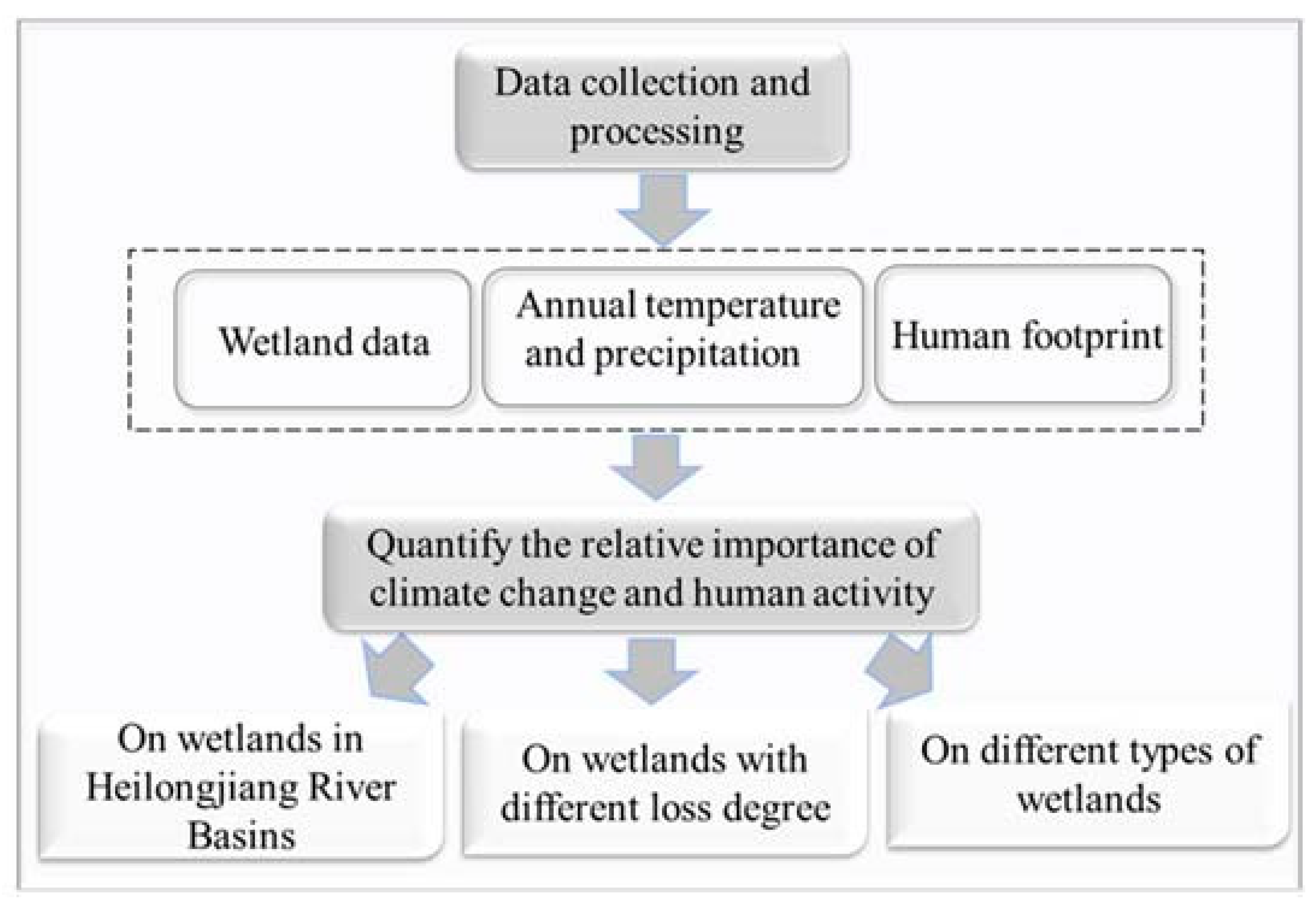
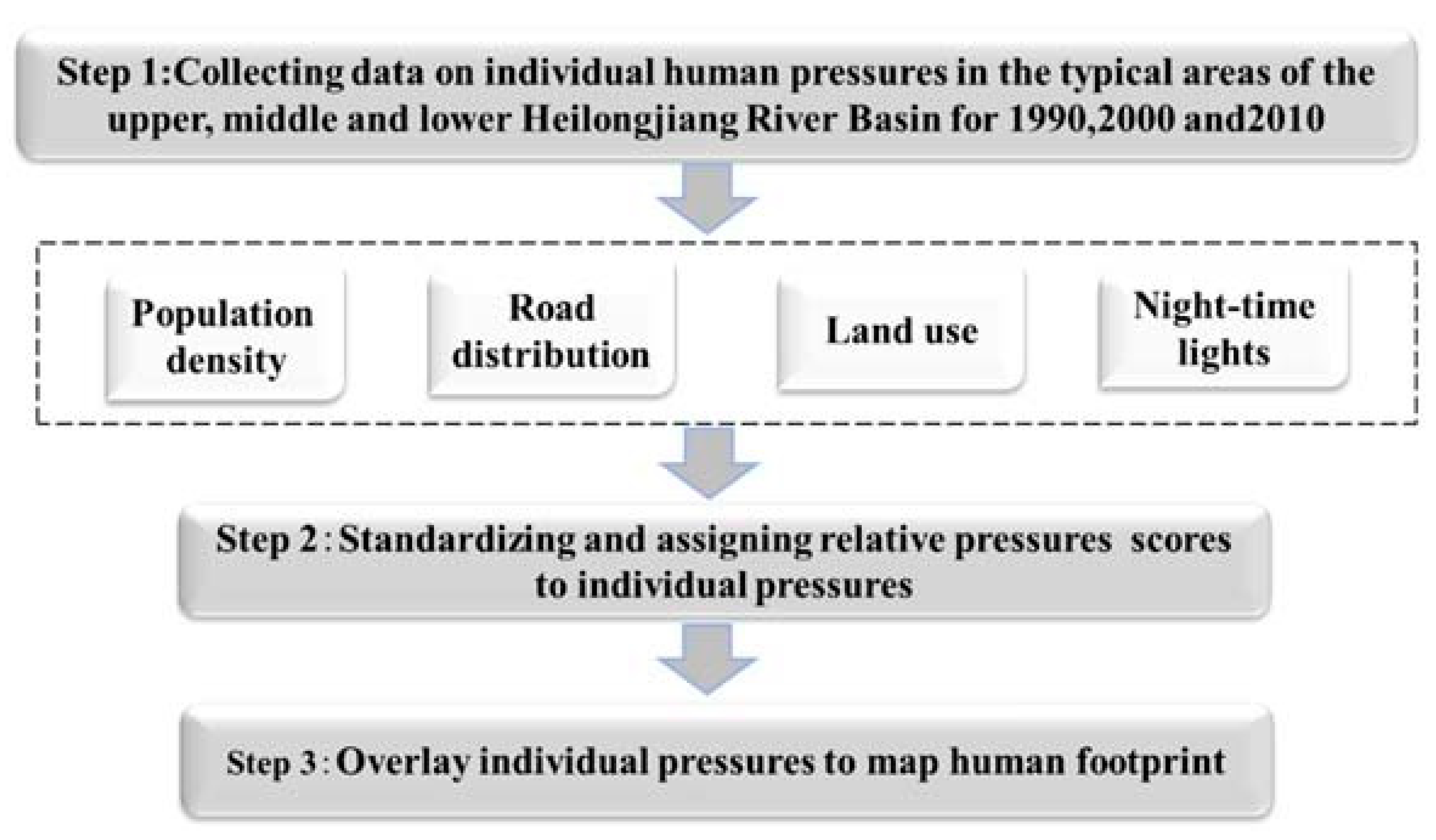
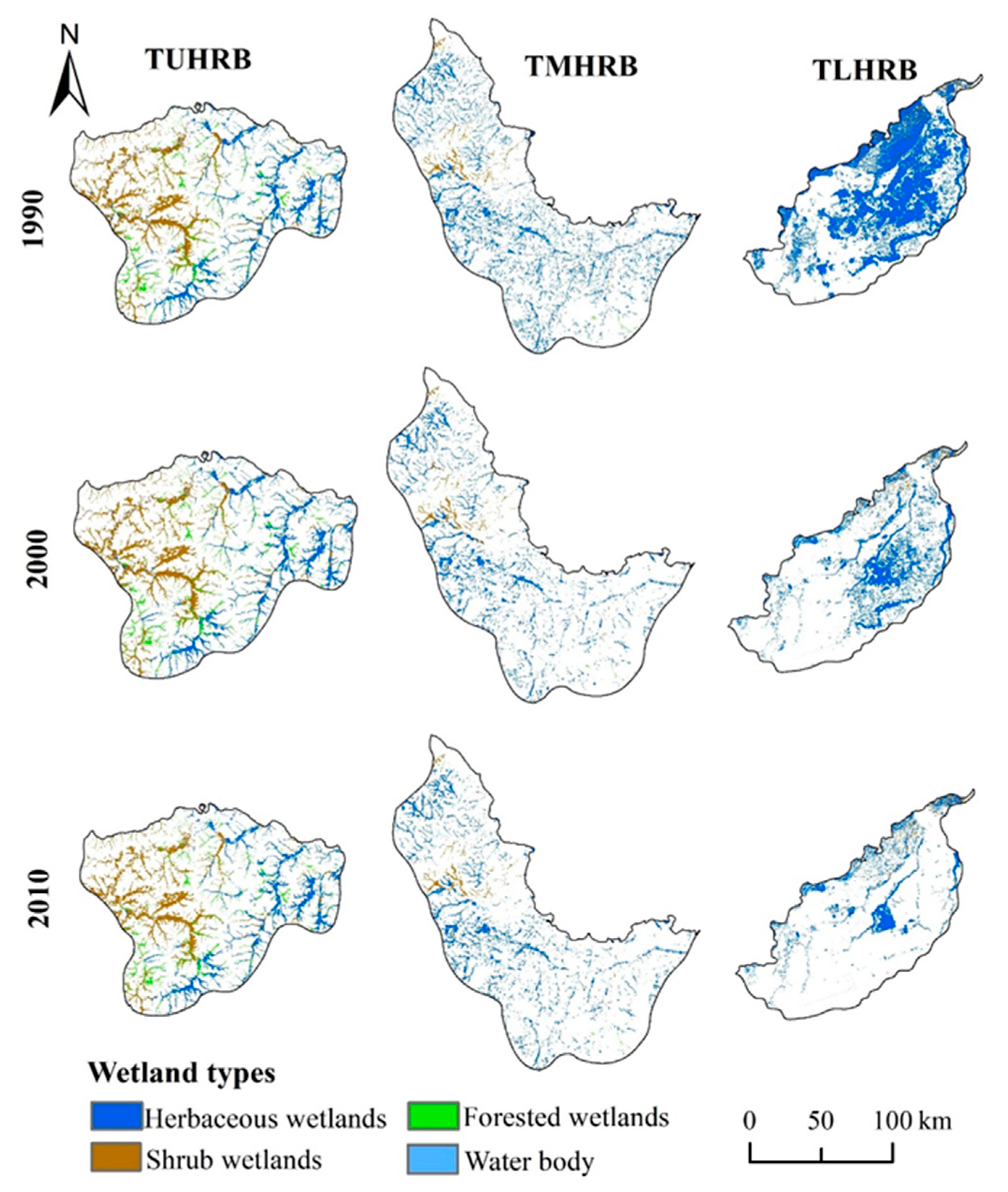
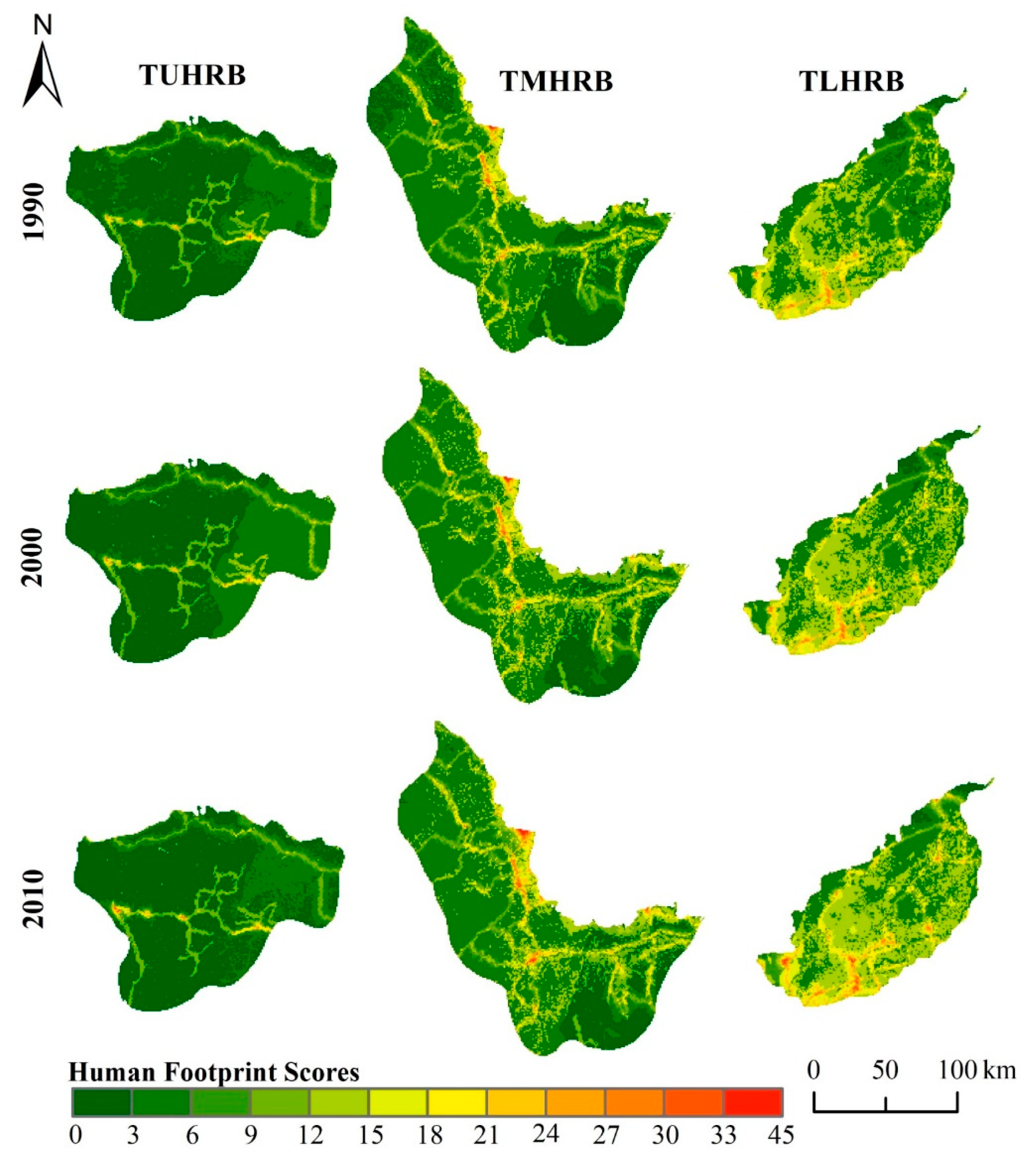
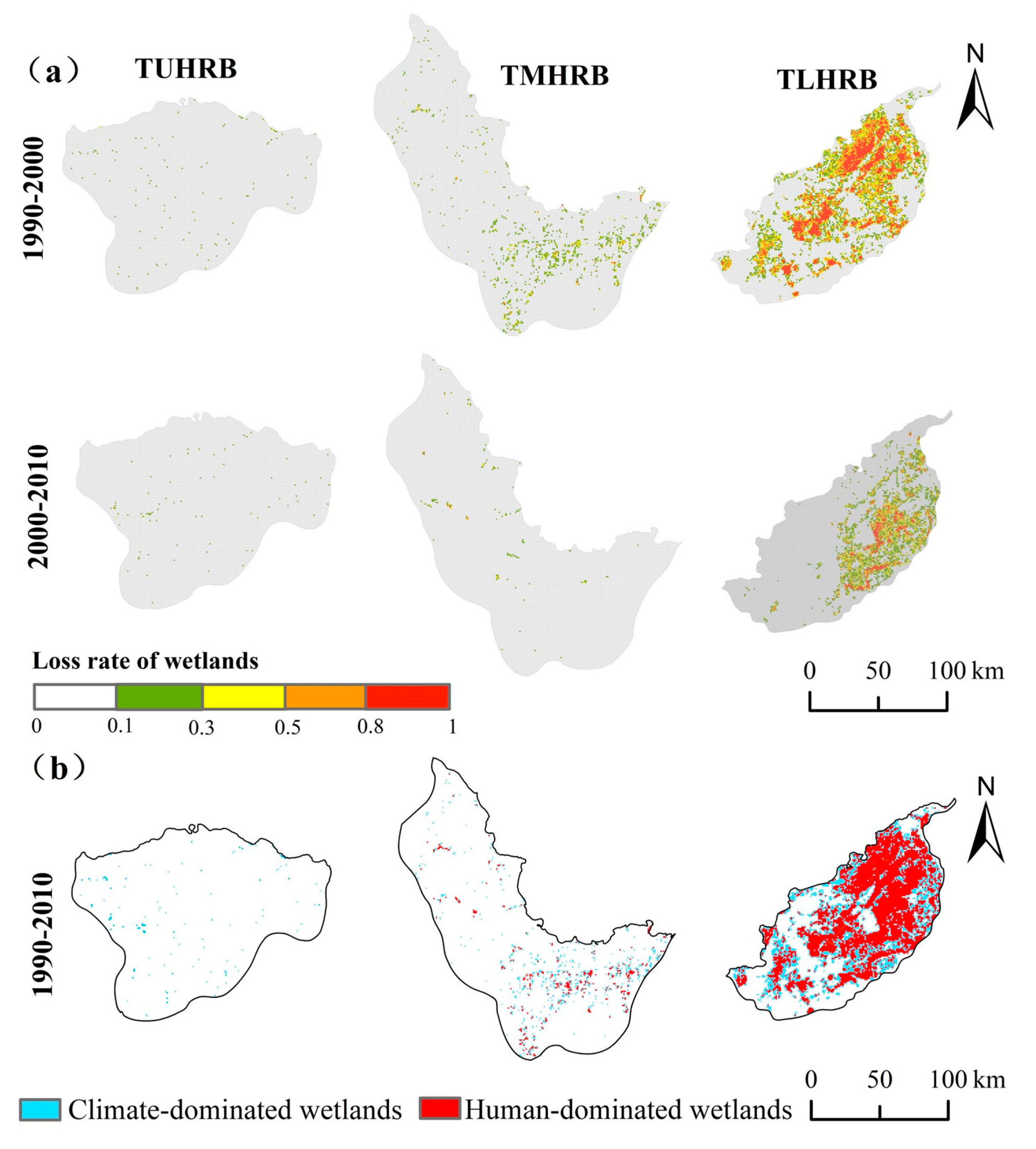

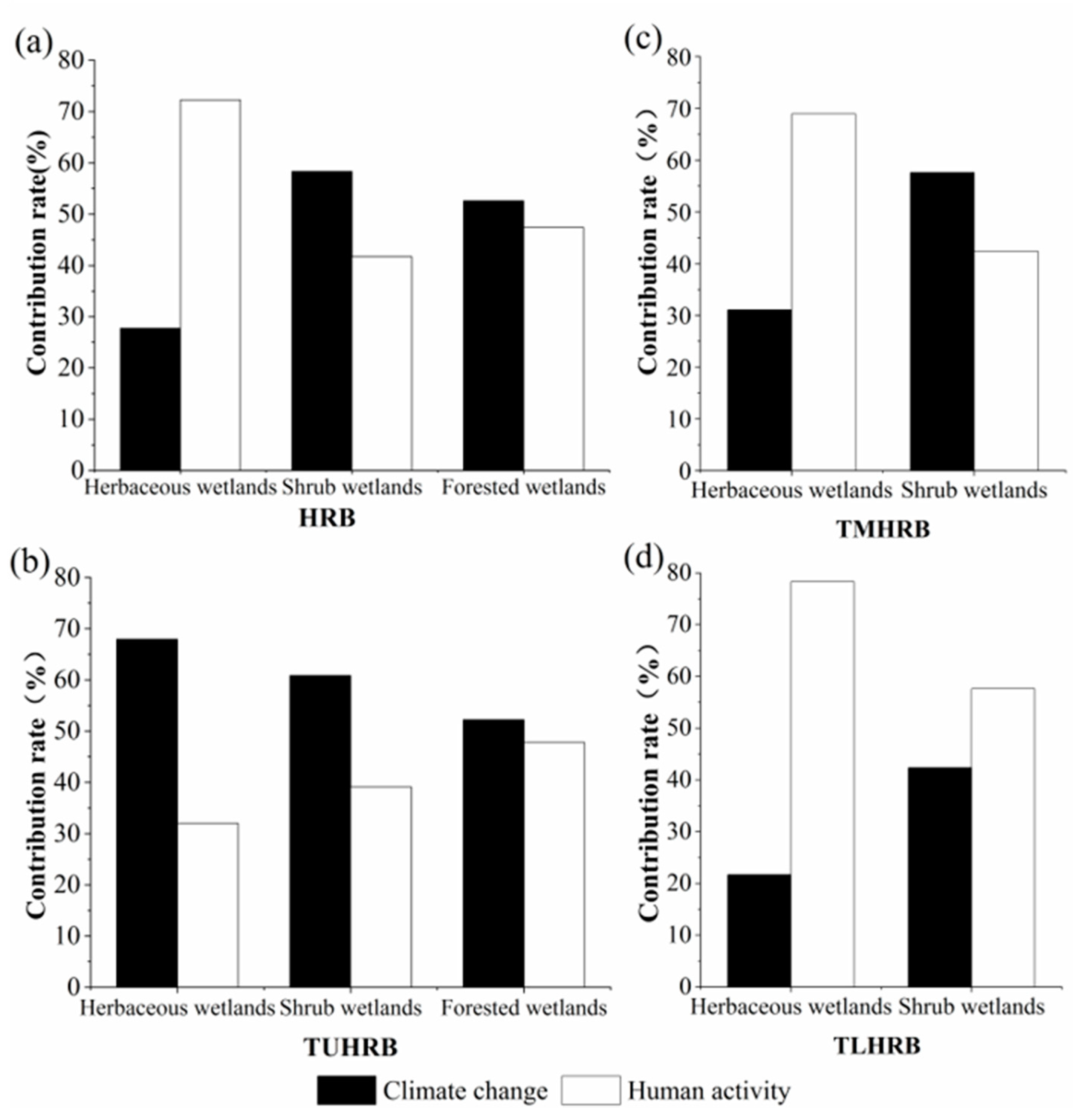
| Land-Use Types | Descriptions | Scores |
|---|---|---|
| Built-up land | Refers to land use in large, medium and small cities and built-up areas above county and town levels | 10 |
| Rural settlements | Refers to rural settlements independent of cities and towns | 8 |
| Reservoir/ponds | Refers to the man-made facilities for water reservation | 8 |
| Cropland | Refers to lands for crops, including dry and paddy fields | 7 |
| Grassland | Refers to lands for grassland, including sparse grassland, moderate grassland and dense grassland | 0 |
| Forest land | Refers to lands for woodland, including arbor, shrub and bamboo, etc. | 0 |
| Natural Water | Refers to lands covered by natural water bodies, including stream, rivers, lakes, permanent ice | 0 |
| Unused land | Refers to lands that are not used, including bare land, sandy, saline alkali soil, Gobi and others | 0 |
| Study Areas | Wetland Types | 1990 (km2) | 2000 (km2) | 2010 (km2) | Proportion (%) |
|---|---|---|---|---|---|
| TUHRB | Herbaceous wetlands | 1181.21 | 1176.83 | 1175.19 | 38.59 |
| Shrub wetlands | 1389.59 | 1378.22 | 1371.19 | 45.22 | |
| Forested Wetlands | 519.13 | 499.12 | 463.72 | 16.19 | |
| TMHRB | Herbaceous wetlands | 2695.08 | 2310.55 | 2190.05 | 91.97 |
| Shrub wetlands | 218.11 | 196.54 | 188.33 | 7.71 | |
| Forested Wetlands | 9.07 | 8.17 | 8.1 | 0.32 | |
| TLHRB | Herbaceous wetlands | 5147.78 | 2867.99 | 1636.2 | 96.77 |
| Shrub wetlands | 87.53 | 69.59 | 58.16 | 2.22 | |
| Forested Wetlands | 40.58 | 35.48 | 30.46 | 1.01 |
| Study Areas | 1990 | 2000 | 2010 | Mean Value |
|---|---|---|---|---|
| TUHRB | 3.78 | 3.76 | 3.83 | 3.79 |
| TMHRB | 6.11 | 7.01 | 7.15 | 6.76 |
| TLHRB | 8.66 | 9.69 | 10.7 | 9.68 |
© 2020 by the authors. Licensee MDPI, Basel, Switzerland. This article is an open access article distributed under the terms and conditions of the Creative Commons Attribution (CC BY) license (http://creativecommons.org/licenses/by/4.0/).
Share and Cite
Dang, Y.; He, H.; Zhao, D.; Sunde, M.; Du, H. Quantifying the Relative Importance of Climate Change and Human Activities on Selected Wetland Ecosystems in China. Sustainability 2020, 12, 912. https://doi.org/10.3390/su12030912
Dang Y, He H, Zhao D, Sunde M, Du H. Quantifying the Relative Importance of Climate Change and Human Activities on Selected Wetland Ecosystems in China. Sustainability. 2020; 12(3):912. https://doi.org/10.3390/su12030912
Chicago/Turabian StyleDang, Yongcai, Hongshi He, Dandan Zhao, Michael Sunde, and Haibo Du. 2020. "Quantifying the Relative Importance of Climate Change and Human Activities on Selected Wetland Ecosystems in China" Sustainability 12, no. 3: 912. https://doi.org/10.3390/su12030912
APA StyleDang, Y., He, H., Zhao, D., Sunde, M., & Du, H. (2020). Quantifying the Relative Importance of Climate Change and Human Activities on Selected Wetland Ecosystems in China. Sustainability, 12(3), 912. https://doi.org/10.3390/su12030912





